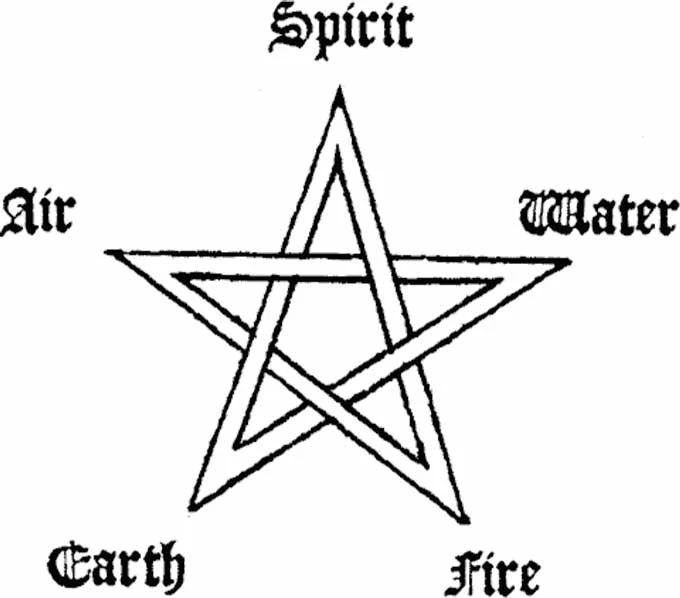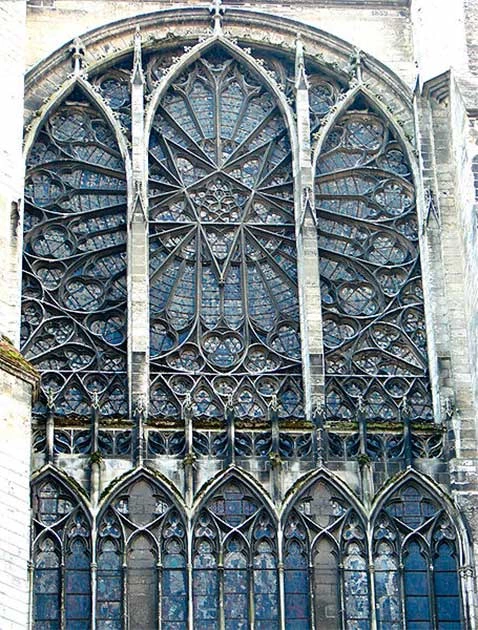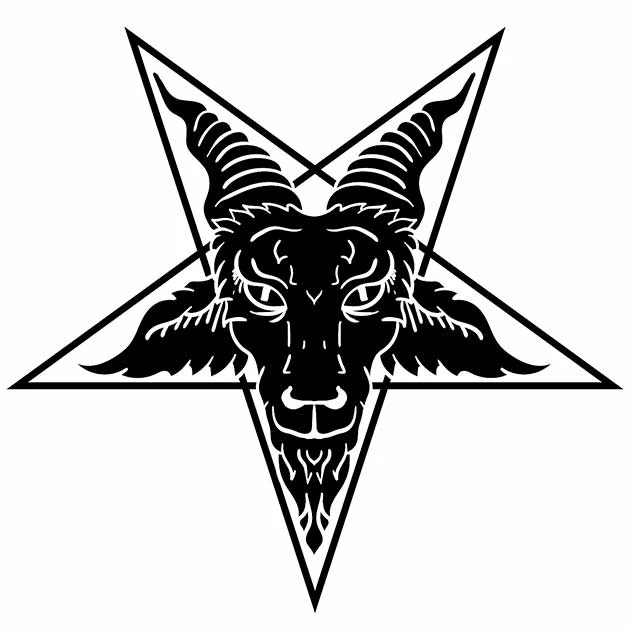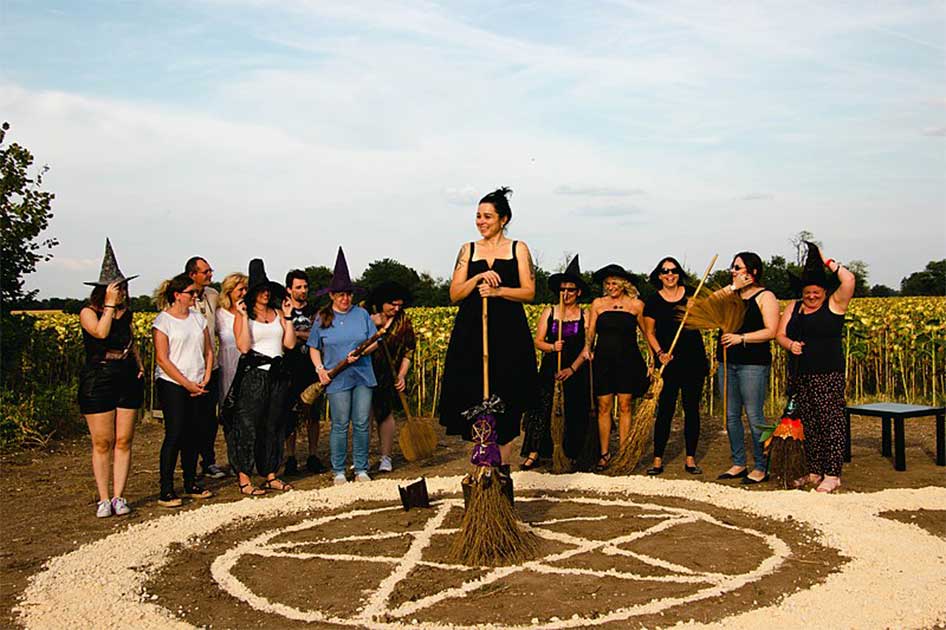Religions are often tied to certain symbols that represent faith and, when worn, are a way of identifying others of the same belief system. Judaism has the Magen David, and Christianity has the cross that takes different forms based on the denomination one belongs to.
There is the Crescent and Star of the Islamic faith and the AUM or OM symbol of Hinduism. These symbols represent faith, piety, protection, and devotion, all good things.
However, not all symbols are associated with “good”; some are associated with “evil.” The pentagram is one of those symbols associated with good and evil for centuries. What is the true meaning of the pentagram? Why is it associated with the occult?
The Pentagram
A pentagram is a five-pointed star used throughout history as a symbol, often related to magic or the occult. The pentagram has had a wide variety of meanings and functions over time.
The pentagram has been a protection symbol, a symbol of perfection (the angles conform to the golden ratio found throughout nature, which is why many find the shape aesthetically pleasing), a symbol of identification, the devil, humanity, and many more. The word pentagram only refers to the star, not a star within a circle.
A pentagram within a circle is called a pentacle which has been used by Wiccans and Pagans. The term pentacle and pentagram have been used to refer to the five-pointed star with or without the circle.

Pentagrams have been found carved into Sumerian pottery from Ur from around 3500 BC, and it was a symbol the ancient Greeks were familiar with. There have been vases found with a pentagram on the body, which scientists believe dates back to the 7th century BC.
The pentagram was used by followers of Pythagoreanism back in the 6th century BC. Pythagoreanism was based on the beliefs and teachings of Pythagoras and his followers, known as Pythagoreans.
For the Pythagoreans, the pentacle was a sign of “mutual recognition, of wellbeing, and to recognize good deeds and charity.” The pentacle used by the Pythagoreans is a five-pointed star that sometimes contained the word ‘ὑγιεία’ which meant “health.”
In the Middle Ages, the pentagram was a Christian symbol that represented the five human senses or the five wounds of Christ. The pentagram appears as a protection/strength/virtuous symbol in the 14th-century English poem “Sir Gawain and the Green Knight”.
- Who Was Aleister Crowley…Occultist, Satanist, and British Spy?
- The Book of Shadows: Is There a Secret Witches’ Spellbook?
The pentagram decorates the shield of the hero, Sir Gawain, and the unnamed and unknown author of the poem credits the symbol to the Biblical King Solomon. The five points of a pentagram in the poem “represent a virtue tied to a group of five: Sir Gawain is perfect in his five senses and five fingers, faithful to the five wounds of Christ, takes courage from the five joys that Mary has of Jesus, and exemplifies the five virtues of knighthood (generosity, friendship, chastity, chivalry, and piety.”
The pentagram appears in sigils for summoning or spells, but this was created by people who thought magic and alchemy were real science. Nothing can be summoned from a pentagram or commands the devil; the belief dates back to the Middle Ages and the Renaissance.

The large stained glass windows in some cathedrals, known as rose windows, sometimes have a pentagram in the center. The Amiens Cathedral in France has an upside-down pentagram as its center, which some religious sources say represents the Holy Spirit descending down onto the people below.
The pentagram only became really associated with magic and the occult by the mid-19th century. It is here where the direction of the pentagram had “significant meaning”.
If the pentagram point’s up, it represents spirit ruling the four elements of matter, so it is a “good” symbol. The “bad” upside-down pentagram earned this reputation from a very controversial but influential writer Éliphas Lévi.
Lévi believed that magic was real and was a science, which is why the inverse pentagram is evil. According to Lévi, “A reversed pentagram, with two points projecting upwards, is a symbol of evil and attracts sinister forces because it overturns the proper order of things and demonstrates the triumph of matter over spirit. It is the goat of lust attacking the heavens with its horns.”
The pentagram is an apotropaic symbol in German folklore and art. An apotropaic symbol, magic, or charm is a form of protective magic. This is a type of magic intended to turn away harmful or evil influences and avert the evil eye.
Another example of a pentagram in Germany used as a protective symbol is from Johann Wolfgang von Gothe’s Faust. Faust uses the pentagram to prevent Mephistopheles from leaving a room, thus trapping him.
Satanism and The Baphomet Pentagram
An inverted pentagram is a symbol used for Satanism and is sometimes depicted with the goat head of Baphomet in the center. The inverted pentagram with the head of Baphomet comes from the modern Church of Satan and is the organization’s logo.

The church was founded in 1966 in San Francisco, California, by Anton Szandor LaVey. LaVey was the dictionary definition of eccentric, and he loved being dramatic, talking about the taboo, and was very into the free love movement in San Francisco in the 1960s.
Members of the Church of Satan do not believe that Satan literally exists, and they do not worship him. While media and pop culture speaks of Satan worship, Satan was an inspirational image in The Church of Satan.
- History of Magic from Dark Art to Pop Entertainment
- The Tophet: Was Ancient Carthage Driven to Child Sacrifice?
According to The Church of Satan’s website, “Satan is viewed as a positive archetype embracing the Hebrew root of the word ‘Satan’ as ‘adversary’, who represents enlightenment, pride, and carnality.” Satan is representative of the true self, the part of you that is jealous, prideful, and wanton; it is your sexual and personal desires. The things you have deep inside you that you keep locked up and suppressed because religion has told you those thoughts or feelings are “wrong/shameful.” The motif of using a pentagram to summon the devil was never a part of the Church of Satan.
The Church of Satan provides a lengthy article on the “Sigil of Baphomet” and its use in the church. The goat head inverse pentagram was never used as a primary symbol of Satanism. The Church of Satan’s pentagram became a leading symbol after the publication of The Satanic Bible.
In the past, demons and the devil were denoted with inverted crosses or crucifixes, as well as blasphemous images and parodies of Christian art and iconography. In the Histoire en 1000 Images de la Magie, published in 1961 by Maurice Bessy, the pentagram is described as “… the result of obscure numerological speculations. The five-pointed star, for example, seems to be characteristic of the Christian era, while the cross is the symbol (amongst others) of the figure five: four arms and the center. By a strange coincidence, the Holy Spirit, the United States, and the USSR and Islam used the five pointed star as their emblem. (The opposition of good and evil is indicated through the inverted triangles).”
The pentagram therefore shifts from a Christian symbol or protective symbol to something associated with paganism, witchcraft, and the devil when the pentagram is given the title of “evil”.
Pentagrams and Wicca
Because of the perceived association of pentagrams with Satanism, it is viewed negatively regarding the use of pentagrams in Wiccan rituals and practices. The pentagram in the Wiccan faith is not a symbol or representation of good or evil. It is a symbol of faith.
The pentacle and pentagram represent the Earth, Air, Water, Spirit, and Fire, surrounded by a circle that signifies the universe, which contains and connects all five elements. Some confusion and association of the pentagram and pentacle in Wicca with the devil or evil may stem from the worship and belief in a “Horned God and Mother Goddess.”

In traditional Wicca (British Traditional Wicca), the Horned God is a god of duality. He represents the light and dark, the day and night, winter and summer. In common Wicca (Gardnerian Wicca), the Horned God is associated with nature, the cycle of life, sexuality, hunting, and wilderness.
During and after the “Satanic Panic” of the 1980s through the 1990s, public schools actively prevented students from displaying the pentagram (even if it was just a star and nothing related to religion) on clothing or jewelry. It took until 2000 for banning the pentagram from schools to be recognized as a blatant violation of the student’s First Amendment Right to exercise free speech and religion.
In 2007, the pentacle used in Wicca was approved and added to the list of 38 religious symbols that can be placed on the tombstones of fallen service members at Arlington National Cemetery in Washington, D.C.
A symbol becomes significant when meaning is placed upon it. The pentagram and pentacle are neither good nor evil and cannot summon demons from the depths of hell. It is simply a five-pointed star and a mathematically perfect shape.
Top Image: Pop culture may associate the pentagram with evil, but for many centuries it was a Christian symbol. Source: CsaboPhoto / Adobe stock.